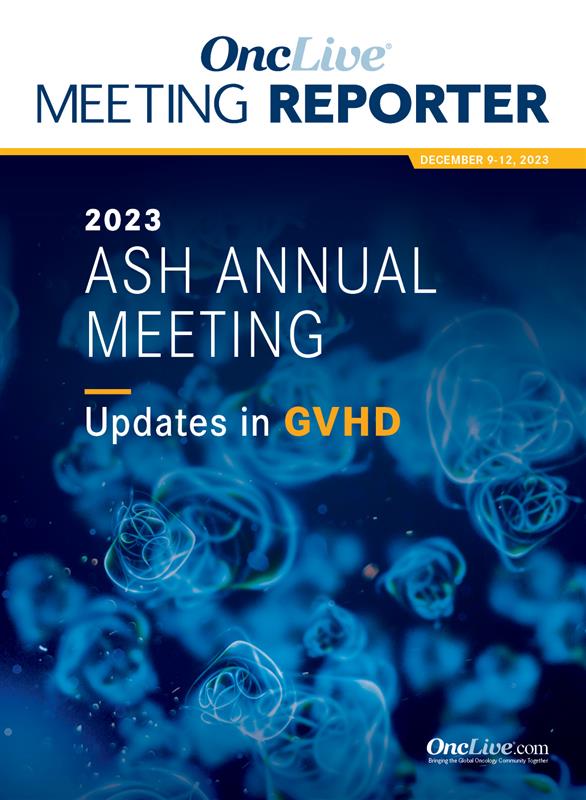News
Article
Supplements and Featured Publications
Ruxolitinib Shows Sustained Efficacy Over Best Available Therapy in Steroid-Refractory/Dependent cGVHD
Author(s):
Treatment with ruxolitinib led to prolonged failure-free survival and improved disease control vs best available treatment in patients with either steroid-refractory or -dependent chronic graft-vs-host disease.
Robert Zeiser, MD

Treatment with ruxolitinib (Jakafi) led to prolonged failure-free survival and improved disease control vs best available treatment in patients with either steroid-refractory or -dependent chronic graft-vs-host disease (cGVHD), according to 3-year data from a final analysis of the phase 3 REACH3 trial (NCT03112603) presented during the 2023 ASH Annual Meeting.1
“Ruxolitinib provided longer PFS and longer DOR vs [best available treatment], demonstrating sustained efficacy for patients with [steroid refractory or dependent] cGVHD, with a consistent and manageable safety profile,” Robert Zeiser, MD, professor in the department of medicine I at the Medical Center at University of Freiburg in Germany, said during a presentation of the data.
Median failure-free survival was longer in the ruxolitinib group compared with the best available treatment group (38.4 months vs 5.7 months; HR = 0.361; 95% CI, 0.268-0.485). The probability of failure-free survival at 12 months was 64.0% in patients assigned ruxolitinib (95% CI, 56.1%-70.8%) and 28.8% in those assigned best available treatment (95% CI, 21.8%-36.1%).
Median overall survival was not reached, and no difference was observed in the risk of death in both groups (HR = 0.851; 95% CI, 0.544-1.331).
Median duration of response was 6.4 months in patients assigned best available treatment (95% CI, 4.9-11.4) and not reached in those assigned ruxolitinib. The likeliness of maintaining duration of response at 3 years was higher in the ruxolitinib group (59.6%; 95% CI, 50.4%-67.6%) vs the best available treatment group (26.7%; 95% CI, 18.5%-35.5%).
The rates of non-relapse mortality were similar in the ruxolitinib (29 out of 165) and the best available treatment groups (34 out of 164). The rates of malignancy relapse events were similar in both arms for up to 3 years, occurring in 13 out of 156 patients assigned ruxolitinib and 11 out of 160 patients assigned best available treatment.
At week 24, the overall response rate in patients who crossed over from best available treatment to ruxolitinib was 50% (95% CI, 37.8%-62.2%). This included a complete response in 5.7% of patients and a partial response in 44.3% of patients. Best overall response during the crossover period was 81.4% (95% CI, 70.3%-89.7%), with complete response in 7.1% and partial response in 74.3%. Of note, 1 patient experienced disease progression.
Adverse Events
During the main treatment period, almost all patients experienced 1 or more adverse events, affecting 100% of patients assigned ruxolitinib and 93.7% of patients assigned best available treatment. Rates of adverse events were higher in the ruxolitinib group vs the best available treatment group. This was likely due to longer follow-up and longer median exposure to ruxolitinib compared with best available treatment (52.9 weeks vs 24.1 weeks).
The most common adverse event was anemia, with 33.9% in the ruxolitinib group and 15.8% in the best available treatment group. Of note, the rate of grade 3 or higher anemia affected the ruxolitinib group more than the best available treatment group (17.6% vs 9.5%). Rates of grade 3 or worse thrombocytopenia, neutropenia, gamma-glutamyltransferase increase, and alanine aminotransferase increase were at 5% higher in patients assigned ruxolitinib compared with best available treatment.
The most common treatment-related adverse events in the ruxolitinib group were anemia, which occurred in 24.2% of patients. Grade 3 or higher anemia also occurred in 10.3% of patients in this group. For patients assigned best available treatment, the most common treatment-related adverse events were thrombocytopenia (3.8%).
Infections, not including tuberculosis, were the most common adverse event of special interest in the ruxolitinib and best available treatment groups (77.6% vs 68.4%, respectively). Grade 3 or higher infections occurred in 31.5% of patients assigned ruxolitinib and 26.6% of those assigned best available treatment.
Most deaths that occurred while on treatment were due to cGVHD, occurring in 10 out of 18 patients assigned ruxolitinib and in 6 out of 12 patients assigned best available treatment.
Study Design
Patients aged 12 years and older with moderate or severe steroid-refractory cGVHD were randomized 1:1 to receive either 10 mg of ruxolitinib twice daily (n = 165) or best available treatment (n = 164), as selected by the investigator. All patients were followed for 3 years, until discontinuation or death.
The primary analysis of the study, which was conducted at week 24 (cycle 7, day 1) in all patients randomized to treatment, then patients entered an extension period from cycles 7 to 39, during which treatment continued, patients switched from best available treatment to ruxolitinib (crossover cohort), or discontinued treatment. Patients who discontinued treatment entered long-term survival follow-up.
At 3 years, researchers analyzed several outcomes including failure-free survival, duration of response, non-relapse mortality, overall survival, safety, and malignancy relapse. The final data cut off was December 15, 2022. In addition, other outcomes were assessed during the crossover treatment period — patients who switched from best available treatment to ruxolitinib on or after cycle 7, day 1—including overall response rate and best overall response.
Of the 329 patients who were randomized to treatment, 53 patients completed the treatment period and 276 patients discontinued. In addition, 115 patients entered survival follow-up, with 73 out of 165 patients from the ruxolitinib group and 42 out of 164 in the best available treatment group. Seventy patients crossed over from best available treatment to ruxolitinib, of whom 16 completed the crossover treatment period and 24 patients entered survival follow-up.
Reference:
Zeiser R, Russo D, Ram R, et al. Ruxolitinib in Patients With Chronic Graft-Versus-Host Disease: 3-Year Final Analysis of Efficacy and Safety From the Phase III REACH3 Study. Blood. 2023;142(1):654. doi:10.1182/blood-2023-172590










